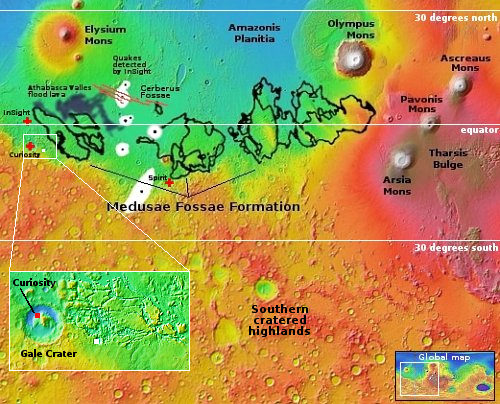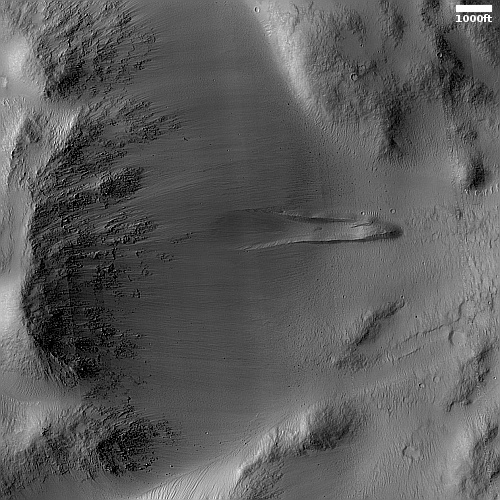Avalanche to the east of Gale Crater on Mars
Cool image time! The picture to the right, cropped, reduced, and sharpened to post here, was taken on February 19, 2023 by the high resolution camera on Mars Reconnaissance Orbiter (MRO). It shows an avalanche that slumped downward out of the material that forms the interior western wall of an unnamed 25-mile-wide crater about 100 miles east of Gale Crater, where Curiosity has been roving for more than a decade.
The scientists call these types of Martian avalanches “mass-wasting events”, since the entire mass of the cliff moves downhill in a chunk, rather than as a pile of rocks that grows in size and strength as it picks up material on its way down.
It is not clear how old this slide is. A lot of the material on this slope appears to be Martian dust, some of which has flowed into the avalanche material after it had slide downhill.

The white dot to the east of Gale Crater in the inset of the overview map to the right marks the location of this landslide. Notice how the terrain east of Gale appears to be similar to chaos terrain, with a slight suggestion that the downhill grade is to the east. In the mid-latitudes of Mars such chaos terrain is often filled with glacial features, with the shaping of this terrain possibly linked to the long-term motion of that ice.
Here in the dry equatorial regions however the evidence suggests there is no near surface ice. If this landslide occurred because of an underground layer of ice, that ice has long ago sublimated away. If so, the slide is very old. Moreover, the chaos terrain might be as old if not older, coming from a time when Mars’ equatorial regions were not dry.
It is also possible that the slide is young, and was caused simply because of the structurally weakness in the alluvial fill that makes up this slope. Much of the dust in this area likely came from the nearby Medusae Fossae Formation, the largest volcanic ash deposit on Mars, from which some scientists believe most of the dust on Mars originates.
On Christmas Eve 1968 three Americans became the first humans to visit another world. What they did to celebrate was unexpected and profound, and will be remembered throughout all human history. Genesis: the Story of Apollo 8, Robert Zimmerman's classic history of humanity's first journey to another world, tells that story, and it is now available as both an ebook and an audiobook, both with a foreword by Valerie Anders and a new introduction by Robert Zimmerman.
The print edition can be purchased at Amazon or from any other book seller. If you want an autographed copy the price is $60 for the hardback and $45 for the paperback, plus $8 shipping for each. Go here for purchasing details. The ebook is available everywhere for $5.99 (before discount) at amazon, or direct from my ebook publisher, ebookit. If you buy it from ebookit you don't support the big tech companies and the author gets a bigger cut much sooner.
The audiobook is also available at all these vendors, and is also free with a 30-day trial membership to Audible.
"Not simply about one mission, [Genesis] is also the history of America's quest for the moon... Zimmerman has done a masterful job of tying disparate events together into a solid account of one of America's greatest human triumphs."--San Antonio Express-News
Cool image time! The picture to the right, cropped, reduced, and sharpened to post here, was taken on February 19, 2023 by the high resolution camera on Mars Reconnaissance Orbiter (MRO). It shows an avalanche that slumped downward out of the material that forms the interior western wall of an unnamed 25-mile-wide crater about 100 miles east of Gale Crater, where Curiosity has been roving for more than a decade.
The scientists call these types of Martian avalanches “mass-wasting events”, since the entire mass of the cliff moves downhill in a chunk, rather than as a pile of rocks that grows in size and strength as it picks up material on its way down.
It is not clear how old this slide is. A lot of the material on this slope appears to be Martian dust, some of which has flowed into the avalanche material after it had slide downhill.

The white dot to the east of Gale Crater in the inset of the overview map to the right marks the location of this landslide. Notice how the terrain east of Gale appears to be similar to chaos terrain, with a slight suggestion that the downhill grade is to the east. In the mid-latitudes of Mars such chaos terrain is often filled with glacial features, with the shaping of this terrain possibly linked to the long-term motion of that ice.
Here in the dry equatorial regions however the evidence suggests there is no near surface ice. If this landslide occurred because of an underground layer of ice, that ice has long ago sublimated away. If so, the slide is very old. Moreover, the chaos terrain might be as old if not older, coming from a time when Mars’ equatorial regions were not dry.
It is also possible that the slide is young, and was caused simply because of the structurally weakness in the alluvial fill that makes up this slope. Much of the dust in this area likely came from the nearby Medusae Fossae Formation, the largest volcanic ash deposit on Mars, from which some scientists believe most of the dust on Mars originates.
On Christmas Eve 1968 three Americans became the first humans to visit another world. What they did to celebrate was unexpected and profound, and will be remembered throughout all human history. Genesis: the Story of Apollo 8, Robert Zimmerman's classic history of humanity's first journey to another world, tells that story, and it is now available as both an ebook and an audiobook, both with a foreword by Valerie Anders and a new introduction by Robert Zimmerman.
The print edition can be purchased at Amazon or from any other book seller. If you want an autographed copy the price is $60 for the hardback and $45 for the paperback, plus $8 shipping for each. Go here for purchasing details. The ebook is available everywhere for $5.99 (before discount) at amazon, or direct from my ebook publisher, ebookit. If you buy it from ebookit you don't support the big tech companies and the author gets a bigger cut much sooner.
The audiobook is also available at all these vendors, and is also free with a 30-day trial membership to Audible.
"Not simply about one mission, [Genesis] is also the history of America's quest for the moon... Zimmerman has done a masterful job of tying disparate events together into a solid account of one of America's greatest human triumphs."--San Antonio Express-News



From the orientation of a few small dunes above and in the craters, it appears the wind blows towards this area depositing the dust that eventually overcomes the stability of the slope causing what appears to be an avalanche similar to snow… Except it doesn’t travel as far in low gravity.
I do enjoy these pictures, constantly reminding myself that this is a different planet! And to think it wasn’t so long ago they truly believed Mars had canals…